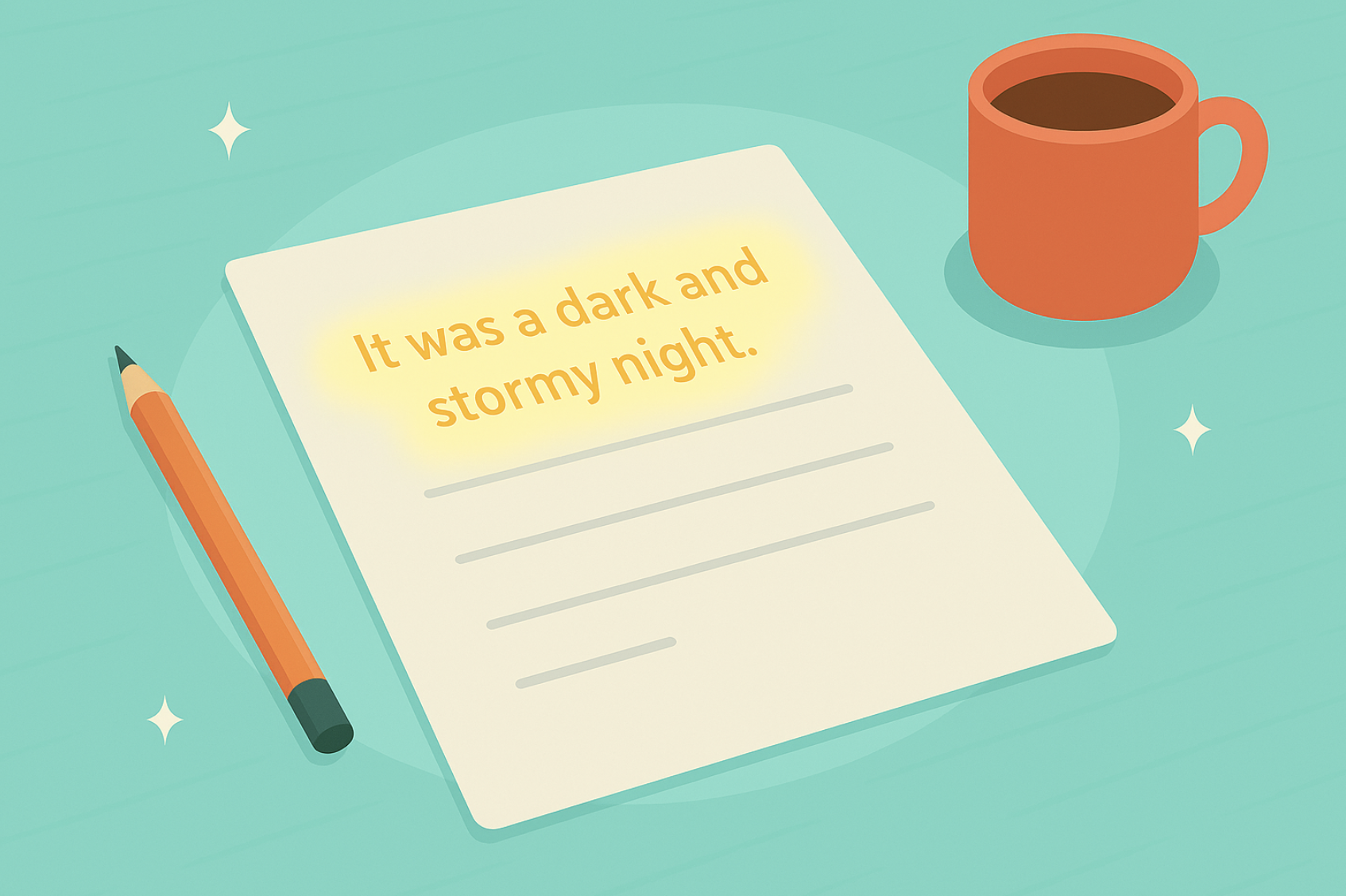We’ve all heard the golden rule of writing: “Show, don’t tell.” But let’s face it—sometimes, it feels like the writing world is asking us to juggle flaming swords while riding a unicycle. Not only do we need to weave vivid scenes and develop complex characters, but we also have to make sure we’re “showing” the action instead of just “telling” it. Easy, right?
In reality, mastering the art of showing vs. telling can take your writing from flat and uninspiring to engaging and dynamic. Whether you’re describing the setting of your story or the depth of your character’s emotions, the right balance of showing can create a stronger connection with your readers and immerse them in your world.
In this post, we’ll break down what “show, don’t tell” really means, why it’s crucial for great storytelling, and share 20 solid examples to help you take your writing to the next level. So, grab your pen (or keyboard) and let’s dive into the world of “showing”—no circus tricks required.
What Does “Show, Don’t Tell” Mean?
This is one of those writing principles that sounds simple enough at first—until you try to put it into practice. Essentially, it means painting a picture for your reader instead of just stating the facts. Instead of telling the reader that a character is sad, for example, you show the sadness through their actions, dialogue, or body language.
Here’s an easy-to-understand example:
- Telling: Sarah was nervous about the job interview.
- Showing: Sarah’s hands trembled as she smoothed her skirt, her breath shallow as she glanced at the clock for the tenth time.
See the difference? In the second example, we get a much clearer picture of Sarah’s anxiety without being explicitly told. The reader can feel the tension through her actions, making the moment more relatable and vivid.
Showing invites the reader to draw their own conclusions, to feel the character’s emotions in real time. Telling, on the other hand, simply informs without evoking much feeling. Think of showing as the movie version of your story and telling as the bullet points in a PowerPoint presentation. One paints a rich picture; the other…well, not so much.
Key Differences Between Show and Tell
Now that we’ve discussed the benefits of showing, let’s explore the key differences between showing and telling. This is where things get interesting because understanding when to show and when to tell is essential for striking the right balance in your writing. Both techniques have their place, but knowing how to use them effectively can make or break a scene.
Show for Emotional Depth, Tell for Efficiency
While showing creates emotional depth, telling is often more efficient. Sometimes, you don’t need to delve deep into a character’s emotions or the details of a setting. You just need to get to the point without slowing down the narrative. Telling allows you to do that.
For instance:
- Telling: It was raining heavily.
- Showing: The rain pelted the windows like a thousand tiny drums, blurring the view and casting the world outside in a constant sheet of gray.
Both statements tell us it’s raining, but the showing version paints a more vivid, sensory picture. However, if the rain isn’t essential to the plot, it might be more effective to simply tell the reader it’s raining and move on.
When to Show: The Emotional or Dramatic Moments
Show when you want to create tension, build suspense, or immerse readers in a significant emotional moment. These are the times when the emotional impact of showing can elevate the scene. Showing works wonders during moments of conflict, excitement, sadness, and joy—anything that draws on the characters’ emotional states.
Example:
- Telling: Mark was nervous about the speech.
- Showing: Mark stood at the podium, his hands slick with sweat. He swallowed hard, staring at the sea of faces, trying to remember what he was supposed to say next.
Here, showing makes us feel Mark’s nerves, placing us right in his shoes. It gives us the sensory experience of his anxiety rather than just telling us he’s nervous.
When to Tell: Unimportant or Background Information
Tell when the details don’t significantly affect the plot or the reader’s emotional connection to the scene. Background information, transitions, and minor details often don’t need to be shown. This helps you maintain pacing and keep the focus on more important elements of the story.
Example:
- Telling: It took them five hours to get to the city.
- Showing: Five long hours of bumping along the dirt road, with nothing but the occasional rustle of trees and the distant hum of the engine.
The showing example adds a little more texture, but if the travel time isn’t crucial to the story, the telling version is likely more efficient.
Striking the Right Balance
The key is balance. If every single moment in your story is shown, it can overwhelm the reader with detail and slow down the pacing. On the other hand, too much telling can leave your readers feeling disconnected from the characters and the action.
In some cases, you can blend both showing and telling in a way that works:
- Example (Blended): She looked out the window, her mind wandering, not caring that the rain had soaked her dress. It had been a long day. Too long. And she still had to face him.
- Analysis: In this example, the first part shows her looking out the window, but the second part tells us she’s exhausted, giving the reader a clear understanding of her state of mind without overloading them with unnecessary details.
The “Telling Details” Trap
Sometimes, when we think we’re showing, we end up slipping into telling details that could be more vivid. Be cautious of phrases that subtly tell rather than show.
For example:
- Telling Detail: She was very scared.
- Showing Detail: Her breath came in sharp bursts, her pulse racing in her neck as she took one slow step toward the door, half-expecting it to swing open on its own.
The second example shows the physical reaction to fear, making it far more immersive and impactful.
20 Showing vs Telling Examples
Now that we’ve covered the differences between showing and telling, it’s time to dive into real-life examples. Here are 20 examples of show don’t tell that illustrate how you can transform flat, telling sentences into immersive, engaging moments that bring your story to life. These examples span different emotions, settings, and situations, giving you a broad toolkit to work from.
Example 1: Character Feeling Sad
- Telling: Mia was sad.
- Showing: Mia stared out the window, her fingers tracing the rim of her coffee cup, her eyes clouded with something too heavy to name.
Example 2: Describing a Setting
- Telling: The forest was quiet.
- Showing: The only sound was the rustling of leaves underfoot and the occasional creak of a distant branch swaying in the wind.
Example 3: A Character’s Excitement
- Telling: John was excited about the surprise.
- Showing: John’s heart raced as he peered around the corner, a grin spreading across his face when he saw the surprise waiting for him.
Example 4: A Romantic Moment
- Telling: They were in love.
- Showing: Their fingers brushed as they walked, a silent connection passing between them, their smiles lingering longer than usual.
Example 5: Fear in a Scene
- Telling: She was afraid of the dark.
- Showing: Her breath hitched as shadows stretched across the room, her feet frozen to the floor, her heart pounding in the silence.
Example 6: Anger During a Confrontation
- Telling: He was angry.
- Showing: His fists clenched at his sides, his jaw tight, and his voice trembled with a barely contained fury as he spoke.
Example 7: Tension Between Characters
- Telling: They didn’t like each other.
- Showing: Each word between them was laced with venom, their eyes avoiding each other, the air thick with unspoken resentment.
Example 8: A Character’s Transformation
- Telling: She was stronger now.
- Showing: She stood taller, her back straight, her gaze unwavering as she faced the world that once intimidated her.
Example 9: A Moment of Success
- Telling: He was proud of his achievement.
- Showing: A wide smile spread across his face as he held the trophy aloft, the room bursting into applause around him.
Example 10: Characters Facing a Challenge
- Telling: They were struggling to climb the mountain.
- Showing: Every step was a battle, their breaths ragged, and the weight of their backpacks pulling them down as they pushed forward, each moment a struggle against the elements.
Example 11: Reactions to a Surprise
- Telling: She was surprised by the gift.
- Showing: Her eyes widened, her hand flying to her mouth as she stared at the wrapped box, disbelief written all over her face.
Example 12: A Setting that Reflects Mood
- Telling: The night felt ominous.
- Showing: The moon hid behind thick clouds, casting long shadows on the ground, while a chill breeze whispered through the empty streets.
Example 13: Describing a Character’s Movements
- Telling: He walked across the room.
- Showing: He shuffled across the room, his feet dragging, each step heavier than the last as if the weight of the world rested on his shoulders.
Example 14: A Character Experiencing Grief
- Telling: She was devastated by the loss.
- Showing: She sank to the floor, her hands trembling as tears blurred her vision, the silence of the room pressing in on her like a heavy blanket.
Example 15: A Thrilling Action Scene
- Telling: The chase was intense.
- Showing: The sound of pounding footsteps echoed in the alley, her breath sharp in her throat as she sprinted, every muscle screaming with effort to outrun her pursuer.
Example 16: Describing Love
- Telling: They were deeply in love.
- Showing: He brushed a stray hair from her face, his fingers lingering on her skin, and she leaned into his touch, their hearts beating in perfect sync.
Example 17: A Character’s Internal Conflict
- Telling: He was torn about his decision.
- Showing: His gaze flickered between the two paths before him, his hands shaking as he gripped the map, every choice feeling like a betrayal.
Example 18: A Dramatic Scene of Betrayal
- Telling: She couldn’t believe he betrayed her.
- Showing: Her breath caught in her throat, her hand flying to her chest as she stared at him, her heart cracking with the realization that the person she trusted most had shattered everything.
Example 19: Characters Sharing a Moment of Humor
- Telling: They laughed together.
- Showing: Their laughter bubbled up in unison, light and carefree, as they exchanged glances, the sound ringing out like music in the still air.
Example 20: A Quiet, Reflective Moment
- Telling: She was lost in thought.
- Showing: She sat by the window, her fingers gently tracing the edge of the glass, her eyes distant, as if she were somewhere far away, lost in a memory only she could touch.
The Benefits of Show vs Tell
Now that we’ve broken down what it means to show rather than tell, let’s talk about why it’s such a game-changer for your writing. Sure, telling might seem easier in the moment—after all, it’s quicker to say “he was angry” than to describe a clenched jaw, a reddening face, and fists that are practically vibrating with frustration. But here’s the thing: showing is what makes your writing come alive. It’s the difference between telling a joke and actually performing it.
Creating Emotional Impact
When you show instead of tell, you allow your readers to feel the emotion instead of simply knowing about it. Think about a time you read something that made your heart race or brought a tear to your eye. Chances are, it wasn’t just a character telling you how they felt—it was their actions, their body language, the way they interacted with their environment that conveyed the emotion.
For example:
- Telling: John was terrified of the storm.
- Showing: John clutched the edge of his seat, his eyes wide as the thunder cracked, the room momentarily illuminated by lightning. He flinched at each gust of wind, as if expecting the house to collapse around him.
In the second example, you can almost feel John’s fear without being explicitly told. The storm becomes a character in the scene, amplifying John’s terror and pulling the reader into the moment.
Making Characters More Real
When characters show their emotions through actions, dialogue, and thoughts, they become multi-dimensional. Instead of being a set of traits and reactions, they start to feel like real people.
Let’s compare:
- Telling: Emily was a hardworking person.
- Showing: Emily didn’t leave the office until the sky had darkened, her fingers stiff from typing but her eyes still glued to the screen. The pile of paperwork on her desk seemed to grow with each passing hour, but she didn’t flinch. She just reached for her coffee and got back to work.
In this example, we understand Emily’s work ethic without being explicitly told. The details—her stiff fingers, the growing pile of work, the lack of hesitation—paint a vivid picture of who Emily is. We get a deeper insight into her character, making her feel more real and relatable.
Enhancing the Reading Experience
Showing adds layers and depth to your writing. It turns simple sentences into immersive experiences. Readers feel like they’re living the moment with the characters, rather than just being observers.
In short, showing creates a much more dynamic and engaging experience for your audience. It turns passive reading into active participation. You’re not just telling them the facts—they’re uncovering those facts themselves through your writing. And that’s what makes storytelling truly magical.
Common Mistakes When Showing vs Telling
Mastering the art of showing vs telling isn’t just about knowing when to show and when to tell—it’s also about avoiding common pitfalls that can make your writing feel forced or unclear. While it’s easy to get excited about all the ways you can “show,” it’s also important to strike the right balance and avoid overdoing it. Here are some common mistakes to watch out for:
Over-Showing (Too Much Detail)
It’s easy to get carried away with showing every single moment in your story. While showing can add richness and depth, too much of it can bog down your narrative and overwhelm the reader. You don’t need to describe every single character movement or environmental detail—focus on the key moments that need to resonate.
- Mistake Example:
John sat in the chair, his back straight, his feet flat on the ground. His hands rested on the armrests, his fingers gripping the edges tightly. His chest rose and fell with each breath, and his gaze never wavered as he stared at the door, waiting for something, or someone, to enter.
This might be a bit much. Instead, focus on the key actions that convey his tension or focus. - Better Version:
John’s gaze was fixed on the door, his hands gripping the chair’s armrests, his breath shallow as he waited.
The second version cuts out unnecessary detail, honing in on what matters most: John’s tension.
Telling When You Should Be Showing
It’s tempting to tell when you’re in a rush or simply unsure how to show an emotion or moment. However, telling can make your writing feel flat and uninspired, especially in moments that could benefit from being more immersive. When emotions or important actions are involved, try to show the experience, not just explain it.
- Mistake Example:
She was terrified of the dark.
You’re missing an opportunity here to immerse the reader in her fear. - Better Version:
She froze at the edge of the hallway, her hand trembling on the light switch, but the darkness seemed to swallow the small beam of light from the hallway lamp, making her stomach churn with unease.
This version puts the reader in the moment, allowing them to feel the terror rather than just reading about it.
Inconsistent Tone Between Showing and Telling
Another mistake occurs when the tone of your showing doesn’t match the tone of the telling. In other words, if you’re describing something with great emotional depth and detail but then throw in a line of telling that doesn’t align with that tone, the balance can be off. Make sure your style stays consistent throughout your piece.
- Mistake Example (Inconsistent Tone):
He looked out the window, mesmerized by the storm. The wind howled, the rain battering the glass. He was scared of what might happen next.
The telling here seems blunt and doesn’t match the intensity of the first two sentences. - Better Version:
He looked out the window, mesmerized by the storm. The wind howled, the rain battering the glass. His heart raced, as if the storm itself had a mind to tear everything apart.
This keeps the tone consistent—both showing and telling add to the mounting tension, keeping the emotion intact.
Overloading Readers with Too Many Telling Details
Sometimes, we tell too many details at once—flooding the reader with information that they don’t need right away. Instead of dumping information in one big chunk, spread it out and use it strategically. If you want to tell something, choose a few impactful details rather than overwhelming the reader.
- Mistake Example:
He was an angry man, always upset with everyone around him. His patience was nonexistent, and he hated people who were late. He didn’t tolerate weakness in others, and he had a quick temper, which made him difficult to be around.
This is too much telling in one go and comes across as flat. - Better Version:
He slammed the door with a force that rattled the windows. The sound of his footsteps echoed down the hallway, each step a sharp reminder of his anger.
The showing here captures the essence of his anger without needing a laundry list of his flaws.
Using Telling to Avoid Writing Scenes
Sometimes, writers turn to telling as a shortcut to avoid writing more detailed, difficult scenes. While it might seem easier to simply tell the reader what happened, skipping over important moments robs your story of depth.
- Mistake Example:
They argued for hours, but in the end, they both agreed to compromise.
This is telling a pivotal moment of the story rather than showing the emotional conflict. - Better Version:
They stood in silence, the air thick with unspoken words. Her arms crossed tightly, his hands clenched at his sides. After what felt like an eternity, he sighed and nodded, his voice barely above a whisper. “I can’t keep doing this.”
By showing the emotional stakes and tension in this moment, you create a more engaging, compelling scene.
How to Avoid These Mistakes:
- Focus on Key Moments: Don’t feel the need to show every single action or emotion. Pick the moments that are crucial to the story’s emotional impact and bring those to life.
- Balance Showing and Telling: Use telling for background information and when you need to keep the pace moving. Show when it will add depth and emotional connection.
- Keep the Tone Consistent: Ensure that your showing and telling match in tone, so the reader remains immersed in the scene.
- Don’t Skip Over Important Scenes: Showing isn’t just about emotion—it’s about making your readers feel as though they’re part of the story. Avoid telling to skip over the moments that matter.
How to Practice Show vs Tell
Like anything in writing, mastering a technique comes with repetition and mindful effort. Fortunately, there are a few practical exercises you can do to sharpen your skills and make this technique second nature.
Rewrite Telling Sentences into Showing Sentences
One of the most effective ways to practice is to take sentences that simply tell and rewrite them in a way that shows the action or emotion. Here’s how you can start:
- Exercise: Take 5–10 sentences from your current work (or even from your favorite book or a random piece of writing), identify where the author is telling instead of showing, and try rewriting them to incorporate more sensory detail.
Use the “Five Senses” Strategy
When you want to show a scene, consider the sensory details. What does the character see, hear, smell, feel, and taste? Using sensory descriptions makes your writing more immersive and helps the reader feel like they’re there with the character. The key is to include only the most relevant senses to the moment.
- Exercise: Describe a scene (setting, character, or action) using as many of the five senses as possible. Start with sight and sound, then consider how you can incorporate the other senses to enrich the scene.
Write a Scene with Only Showing (No Telling Allowed!)
Take a particular emotional scene (like a character’s heartbreak, excitement, or fear) and challenge yourself to write it using only showing. No “telling” phrases allowed, such as “he was sad” or “she felt nervous.” Let the character’s body language, dialogue, and actions convey the emotion.
- Exercise: Write a scene where the character experiences a strong emotion, but only show it. Focus on physical reactions, inner thoughts, and subtle gestures to indicate how the character feels without directly telling the reader.
Analyze Your Favorite Books or Movies for Show vs Tell
Take a moment to analyze scenes from your favorite books or movies and identify where showing vs telling is used effectively. Consider how the writer or filmmaker conveys emotion, tension, and setting without relying on direct explanations.
- Exercise: Watch a scene from a movie or read a passage from a book and ask yourself, “How does the author or director show the emotions or actions? What clues do they give me to feel what the characters are experiencing?”
This exercise helps you analyze and internalize the techniques other successful storytellers use, giving you the tools to apply them to your own writing.
Join a Writing Group or Workshop
Another great way to improve your showing skills is to get feedback from others. Joining a writing group or workshop gives you a chance to share your work and receive constructive criticism. Other writers can point out where you might be telling rather than showing, and you can offer similar feedback to others in return.
- Exercise: Share a piece of writing (or an excerpt) with your writing group or critique partner. Specifically ask them to look for areas where you can shift from telling to showing. Take their feedback into account and revise accordingly.
Group feedback provides fresh perspectives and can help you identify blind spots in your writing. Plus, it encourages you to keep experimenting with different approaches to showing.
Examples of Show Don’t Tell in Writing
Here are three examples of show don’t tell from well-known books that demonstrate how authors use vivid details to immerse readers in the moment:
- “The Great Gatsby” by F. Scott Fitzgerald
“In his blue gardens men and girls came and went like moths among the whisperings and the champagne and the stars.”
This description shows the carefree, almost ethereal atmosphere of Gatsby’s parties without directly telling us how extravagant or fleeting they were. - “Harry Potter and the Sorcerer’s Stone” by J.K. Rowling
“Harry was looking at the large wooden door. There was something familiar about it… something important.”
Instead of telling the reader how significant the door is, Rowling shows Harry’s growing curiosity and instinct that something important is about to happen. - “To Kill a Mockingbird” by Harper Lee
“Jem’s hand, which was resting on the top of the Radley porch, was as hot as a log in a fire.”
This metaphor vividly conveys the tension and fear Jem feels, showing his emotional state through the physical sensation of his hand.
These quotes reveal the power of showing, pulling the reader deeper into the narrative by using sensory details and emotions rather than merely explaining them.
Wrapping It Up: Your Show, Don’t Tell Superpower
You’ve now unlocked one of writing’s most powerful techniques—showing instead of telling! With practice, you’ll elevate your writing, creating stronger connections with your readers and bringing your characters to life. Remember, it’s all about balance. Use showing for emotional depth and vivid moments, but don’t be afraid to tell when you need to keep the pace moving.
Keep practicing, seek feedback, and always stay curious about how other writers balance the two techniques. The more you write, the more natural showing will become, and soon it’ll be your secret weapon for crafting unforgettable stories.
Your Publishing Journey Awaits – Start NowFAQs – Show Don’t Tell Examples
Q1: What is the golden rule of show don’t tell?
The golden rule is to convey emotions, actions, and settings through sensory details, dialogue, and character behaviors rather than explicitly stating them. Instead of telling the reader what a character is feeling, you show it by describing their reactions, body language, and environment. This engages the reader and allows them to experience the story more vividly.
Q2: How to show not tell excitement?
To show excitement, focus on physical reactions, fast-paced movements, and expressive dialogue. Describe the character’s body language, tone of voice, and actions that convey energy and enthusiasm.
- Example: Instead of saying, “She was excited about the concert,” you could show it with, “Her feet bounced on the spot as she grabbed her coat, her eyes sparkling with anticipation.”
Q3: How to show not tell crying?
To show crying, describe the character’s physical and emotional state. Focus on body language, facial expressions, and the impact the emotion has on their surroundings.
- Example: Instead of writing, “He was crying,” you could show it with, “Tears streaked down his face, his chest heaving with each sob as he wiped his eyes with the back of his hand.”
Q4: What are examples of show and tell?
Show and tell are techniques used in writing, and while showing brings scenes to life, telling serves to provide essential or background information. Here are examples:
- Show: “Her hands trembled as she clutched the letter, her breath shallow as she read the words again.”
- Tell: “She was nervous about the letter.”
Q5: How to show curiosity in writing?
Curiosity can be shown by describing a character’s focused actions, questioning tone, or their heightened awareness of their surroundings.
- Example: Instead of saying, “He was curious about the old house,” you could show it with, “He leaned forward, peering through the dusty window, his brow furrowed as he tried to make sense of the dark shape inside.”
Q6: What is an example of show not tell in film?
In film, showing instead of telling is achieved through visuals, acting, and cinematography. A great example is a character’s facial expressions or body language during a tense moment.
- Example: In The Shawshank Redemption, instead of telling us Andy is feeling hopeless, the camera lingers on his weary face, his posture slumped, and his eyes distant, conveying his despair without words.
Q7: How to master show don’t tell?
Mastering “show, don’t tell” requires consistent practice and observation. Begin by identifying moments in your writing where you’re telling and experiment with showing those emotions, actions, or descriptions. Use sensory details, metaphor, and body language to convey feelings. Also, read other authors’ work to see how they balance showing and telling, and incorporate what works into your own writing.







